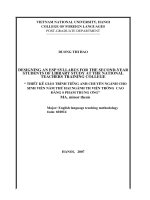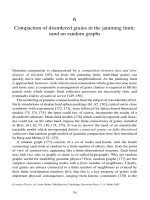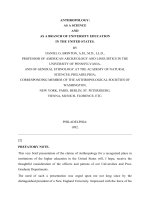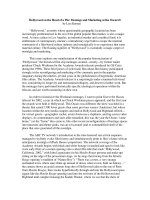Shaking a box of sand II – at the jamming limit, when shape matters
Bạn đang xem bản rút gọn của tài liệu. Xem và tải ngay bản đầy đủ của tài liệu tại đây (248.74 KB, 11 trang )
8
Shaking a box of sand II – at the jamming limit,
when shape matters!
In this chapter we extend the model of the previous chapter in two different direc-
tions; the first and most important aim is to introduce long-range interactions with
a view to obtaining properly glassy behaviour, and the second is to explore the role
of grain shapes in granular compaction.
The model [34, 35] is based on the following picture. Consider a box of sand in
the presence of gravity in the jamming limit. Adopting, as in the previous chap-
ter, a lattice-based viewpoint, we visualise this box as being constituted of rows
and columns of grains. When this box is shaken along the direction of gravity,
the predominant dynamical response of the sandbox is known to be in the vertical
direction – recall the on- and off-lattice computer simulation results presented in
earlier chapters [61, 62, 75, 130, 174] which show that correlations in the trans-
verse plane (i.e. along rows of grains) are negligible compared to these. Another
important aspect of the jamming limit is that grain-sized voids are typically absent.
The dominant dynamical mechanism in this regime is therefore grain reorientation
within each column to minimise the size of the partial voids that persist. We thus
focus on a column model of grains in the jamming limit [34, 35].
We now extend the concept of disorder to include the effect of grain shapes. Each
ordered grain occupies one unit of space, while each disordered grain occupies 1 +
units of space, with a measure of the partial void trapped by misorientation.In
changing the notation of wasted space from a as in the previous chapter to here,
we have in mind that, unlike the way in which we envisaged a as the aspect ratio of
a rectangular grain there, can take any value, rational or irrational, in this chapter.
It can, in this chapter, equally represent the integer-value mismatch of rectangular
grains, as the possibly irrational value of the void space generated when an irregular
grain is packed in its most misoriented way. Of course, in restricting ourselves to a
two-state model, we are greatly simplifying the picture, since in real life irregular
Granular Physics, ed. Anita Mehta. Published by Cambridge University Press.
C
A. Mehta 2007.
104
8.1 Definition of the model 105
grains can have a multiplicity of orientational states. We proceed (with this caveat in
mind), however, with the view to understanding as much as possible of this minimal
model.
The basis of the dynamics in this model is strictly local, as in real life. Each
grain feels a local field from all the grains above it (we have in mind that the
topmost grains are the freest to move, while those below are increasingly ‘weighed
under’), and in the jamming limit, it responds to this local field by minimising the
void space available to it. There is an interesting parallel here with the economic
history of families – those families with a history of financial prudence gift their
descendants with resources that they can choose to waste, while in the obverse
case, the descendants have to mop up the debts of their progenitors. Likewise in
this column model – we will see that if the space wasted by all the grains above a
particular one is minimal, the local field on it will be small, and it will be relatively
free to choose either an ordered or a disordered state with respect to this field.
Conversely, if most of the space resources of the column have already been used up
by upper grains, the grain will be constrained to adopt only that orientation which
will mop up the extra void space, and transmit a lower value of local field to grains
below itself.
8.1 Definition of the model
In the column model of [34, 35] grains are indexed by their depth n measured from
the free surface. Each grain can be in one of two orientational states – ordered
(+) or disordered (−) – the ‘spin’ variables {σ
n
=±1} thus uniquely defining a
configuration. As in the random graphs model [152, 153] presented in an earlier
chapter, a local field h
n
constrains the temporal evolution of spin σ
n
, such that
excess void space is minimised.
In the presence of a vibration intensity , grains reorient with an ease that depends
on their depth n within the column (grains at the free surface must clearly be the
freest to move!), as well as on the local void space h
n
available to them. The main
extension of the model described in the earlier chapter [174] is in the transition
probabilities, which are now written as
w
σ
n
=±→σ
n
=∓
= exp
−n/ξ
dyn
∓ h
n
/
. (8.1)
The dynamical length ξ
dyn
[34, 35, 174] is, as before, the boundary layer of the
column; within this dynamics are fast, while well beyond it they are slow. The local
field h
n
is a measure of excess void space [21]:
h
n
= m
−
n
− m
+
n
, (8.2)
106 When shape matters at the jamming limit
where m
+
n
and m
−
n
are respectively the numbers of + and − grains above grain n.
The definition, Eq. (8.2), is such that a transition from an ordered to a disordered
state for grain n is hindered by the number of voids that are already above it, as
might be expected for an ordering field in the jamming limit.
In the → 0 limit of zero-temperature dynamics [152, 153], the probabilistic
rules (8.1) become deterministic: the expression σ
n
= sign h
n
(provided h
n
= 0)
determines the ground states of the system. Frustration [148] manifests itself for
>0, which leads to a rich ground-state structure, whose precise nature depends
on whether is rational or irrational. The connection with the model presented in
the earlier chapter [174] is obtained by setting <0; this corresponds to a complete
absence of frustration and a single ground state of ordered grains, as obtained there.
For irrational , no local field h
n
can ever be zero (see (8.2)). Noting that irrational
values of denote shape irregularity, we conclude that the excess void space is
nonzero even in the ground state of jagged grains. Their ground state, far from
being perfectly packed, turns out [34, 35] to be quasiperiodic.
Regularly shaped grains correspond to rational = p/q, with p and q mutual
primes. We see from (8.2) that now, some of the h
n
can vanish; these correspond,
as noted in a previous chapter, to ‘rattlers’. A rattler at depth n thus has a perfectly
packed column above it, so that it is free to choose its orientation [34, 35, 124,
152, 153]. For regular grains in their ground state, rattlers occur periodically (as
in crystalline packings!) at points such that n is a multiple of the period p + q.
1
Every ground state is thus a random sequence of two patterns of length p + q,
each containing p ordered and q disordered grains; this degeneracy leads to a zero-
temperature configurational entropy or ground-state entropy = ln 2/( p + q) per
grain.
8.2 Zero-temperature dynamics: (ir)retrievability of ground states,
density fluctuations and anticorrelations
Regular and irregular grains behave rather differently when submitted to zero-
temperature dynamics. The (imperfect) but unique ground state for irregular grains
is rapidly retrieved; the perfect (and degenerate) ground states for regular grains
never are, resulting in density fluctuations.
We recall the rule for zero-temperature dynamics:
σ
n
→ sign h
n
. (8.3)
1
For example, when = 1/2, each disordered grain ‘carries’ a void half its size; units of perfect packing must be
permutations of the triad +−−, where two ‘half’ voids from each of the disordered grains are perfectly filled
by an ordered grain. The stepwise compacting dynamics [34, 35] selects only two of these patterns, +−−and
−+−.
8.2 Zero-temperature dynamics 107
Fig. 8.1 Log–log plot of W
2
n
=h
2
n
against depth n, for zero-temperature dynam-
ics with = 1. Full line: numerical data. Dashed line: fit to asymptotic behaviour
leading to (8.4) (after [34, 35]).
Starting with irregular grains (with a given irrational value of ) in an initially disor-
dered state, one quickly recovers the ground state with zero-temperature dynamics.
The ground state in fact propagates ballistically from the free surface to a depth
L(t) ≈ V () t [34, 35] at time t, while the rest of the system remains in its dis-
ordered initial state. When L(t) becomes comparable with ξ
dyn
, the effects of the
free surface begin to be damped. In particular, for t ξ
dyn
/V () we recover the
logarithmic coarsening law L(t) ≈ ξ
dyn
ln t, also seen in other theoretical mod-
els [152, 153, 174] of the slow relaxation of tapped granular media [172, 173]. To
recapitulate, the ground state for irregular grains is quickly (ballistically) recovered
with zero-temperature dynamics, until the boundary layer ξ
dyn
is reached; below
this, the column is essentially frozen, and coarsens only logarithmically.
For regular grains with rational , the local field h
n
in (8.3) vanishes for rattlers.
Their dynamics is stochastic even at zero temperature, since they have a choice
of orientations: a simple way to update them is according to the rule σ
n
→±1
with probability 1/2. This stochasticity results in an intriguing dynamics even well
within the boundary layer ξ
dyn
, while the dynamics for n ξ
dyn
is, as before,
logarithmically slow [34, 35].
In what follows, we will focus on the fast dynamics within the boundary layer.
The main result is that zero-temperature dynamics does not drive the system to any
of its degenerate ground states, but instead engenders a fast relaxation to a nontrivial
steady state, independent of initial conditions, which consists of unbounded density
fluctuations. This recalls density fluctuations close to the jamming limit [152, 153,
172, 173], in other studies of granular compaction.
Figure 8.1 shows the variation of these density fluctuations as a function of
depth n:
W
2
n
=h
2
n
≈An
2/3
, A ≈ 0.83. (8.4)
108 When shape matters at the jamming limit
Fig. 8.2 Scaling plot of the orientation correlation function c
m,n
for n = m in the
zero-temperature steady state with = 1, demonstrating the validity of (8.5) and
showing a plot of (minus) the scaling function F (after [34, 35])
The fluctuations are approximately Gaussian, with a definite excess at small values:
|h
n
|∼1 W
n
. We recall that non-Gaussianness was also observed in experiments
on density fluctuations in tapped granular media [184]; in the theory here, we
interpret it in terms of grain (anti)correlations. If grain orientations were fully
uncorrelated, one would have the simple result h
2
n
=n, while (8.4) implies that
h
2
n
grows much more slowly than n.
It turns out that, at least within a dynamical cluster of radius n
2/3
[34, 35], the
orientational displacements of each grain are fully anticorrelated. Figure 8.2 shows
that the orientation correlations c
m,n
=σ
m
σ
n
scale as [34, 35]
c
m,n
≈ δ
m,n
−
1
W
m
W
n
F
n − m
W
m
W
n
, (8.5)
where the function F is such that
+∞
−∞
F(x)dx = 1. We find also that, within such
a dynamical cluster, the fluctuations of the orientational displacements are totally
screened:
n=m
c
m,n
≈−c
m,m
=−1. These results recall the anticorrelations in
grain displacements observed in independent simulations of shaken hard spheres
close to jamming [61, 62, 130] that were presented in Fig. 3.6; there they corre-
sponded to compaction via bridge collapse, as upper and lower grains in bridges [21]
collapsed onto each other, releasing void space. Again, this model-independent
observation confirms the robustness of the phenomenon: grain displacements are
typically anticorrelated near jamming.
8.3 Rugged entropic landscapes: Edwards’ or not?
The most remarkable feature of the column model is, arguably, the rugged landscape
of microscopic configurations visited during the steady state of zero-temperature









